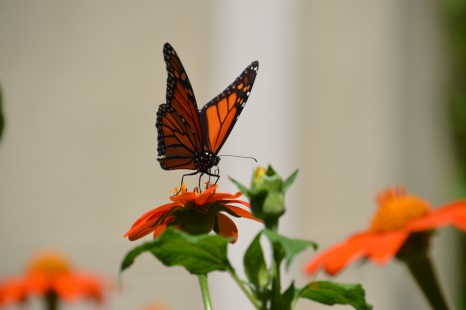This week, Hannah, a monthly blog correspondent and alumni of the Bucktails, Drummers, and Brookies field schools, writes about considering our more “showy” pollinators in the garden. She takes us deeper into the world of butterflies, and why they are key players on the pollinator field.
Hannah K.
Honeybees and bumblebees are the best known pollinators, but they are not the only pollinators. Some of the most graceful and beautiful pollinators are butterflies, as they silently ‘flit” from flower to flower. They may not be as efficient as bees in pollinating, but they still do a good portion of pollinating plants, particularly diurnal flowers, those that only open by day. Butterflies have color vision, seeing more wavelengths than bees. Therefore, they are more likely to pollinate big, beautiful, brightly colored blooms. They gather pollen on their long thin legs as they walk about flower clusters. Choosing the right flower is only one challenge pollinators encounter. It can take the butterfly up to 20 seconds to actually find the right spot on the flower to get the nectar.
Butterflies tend to like flower nectar containing high amounts of amino acids, according to researchers from the University of Basel in Switzerland. This theory was tested by feeding butterflies nectar with and without amino acids. The University concluded butterflies that consume nectar with amino acid lay more eggs than those that do not consume amino acid. They also speculated that the scent of the flower itself attracts butterflies. It is believed the scent of some flowers is similar to the butterfly’s pheromones, a chemical produced and secreted by species to attract the opposite sex of the same species. No correlation was drawn, however, between scent of the flower and the amount of amino acid in the nectar.
These graceful insects are not considered popular pollinators because they are not major pollinators in cash food crops. Butterflies are “second class” compared to bees, based on commercial production. However, they are a key player when it comes to pollinating many native plants and flowers, everywhere in the world except Antarctica. There are about seven hundred different species of butterflies that live in the United States. The butterfly’s beauty and mystery have enchanted mankind for centuries. They are a leading indicator of an ecosystem’s health because of their fragility to ecological change, making them very beneficial.
For over a decade I have been promoting Waystation development. This includes planting host and nectar plants for butterflies. Many butterfly species have seen a decline in population due to pesticide/herbicide use, deforestation and land clearing, and extreme weather conditions. While the weather can’t be controlled, as Conservation Ambassadors we can educate the public regarding the other threatening issues.
What’s good for the Birds, is good for the Bees, is good for the Butterflies. ”B” a friend to them all.
Beneficials in the Garden
Posted: February 14, 2017 by Katie Cassidy
This week, Hannah, a monthly blog correspondent and alumni of the Bucktails, Drummers, and Brookies field schools, writes about considering our more “showy” pollinators in the garden. She takes us deeper into the world of butterflies, and why they are key players on the pollinator field.
Honeybees and bumblebees are the best known pollinators, but they are not the only pollinators. Some of the most graceful and beautiful pollinators are butterflies, as they silently ‘flit” from flower to flower. They may not be as efficient as bees in pollinating, but they still do a good portion of pollinating plants, particularly diurnal flowers, those that only open by day. Butterflies have color vision, seeing more wavelengths than bees. Therefore, they are more likely to pollinate big, beautiful, brightly colored blooms. They gather pollen on their long thin legs as they walk about flower clusters. Choosing the right flower is only one challenge pollinators encounter. It can take the butterfly up to 20 seconds to actually find the right spot on the flower to get the nectar.
Butterflies tend to like flower nectar containing high amounts of amino acids, according to researchers from the University of Basel in Switzerland. This theory was tested by feeding butterflies nectar with and without amino acids. The University concluded butterflies that consume nectar with amino acid lay more eggs than those that do not consume amino acid. They also speculated that the scent of the flower itself attracts butterflies. It is believed the scent of some flowers is similar to the butterfly’s pheromones, a chemical produced and secreted by species to attract the opposite sex of the same species. No correlation was drawn, however, between scent of the flower and the amount of amino acid in the nectar.
These graceful insects are not considered popular pollinators because they are not major pollinators in cash food crops. Butterflies are “second class” compared to bees, based on commercial production. However, they are a key player when it comes to pollinating many native plants and flowers, everywhere in the world except Antarctica. There are about seven hundred different species of butterflies that live in the United States. The butterfly’s beauty and mystery have enchanted mankind for centuries. They are a leading indicator of an ecosystem’s health because of their fragility to ecological change, making them very beneficial.
For over a decade I have been promoting Waystation development. This includes planting host and nectar plants for butterflies. Many butterfly species have seen a decline in population due to pesticide/herbicide use, deforestation and land clearing, and extreme weather conditions. While the weather can’t be controlled, as Conservation Ambassadors we can educate the public regarding the other threatening issues.
What’s good for the Birds, is good for the Bees, is good for the Butterflies. ”B” a friend to them all.
Category: Youth Blog Tags: Brookies, Bucktails, drummers, education, habitat, monarch butterflies, outdoors, youth